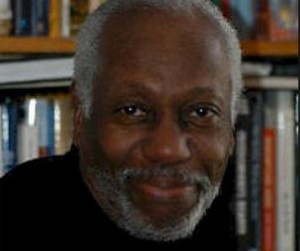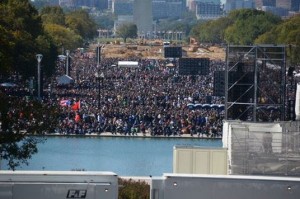
Herb Boyd
NEW YORK – Since I have to teach on Saturdays at the City College of New York it was not possible for me to attend the 20th anniversary of the Million Man March in the nation’s capital. I doubt if I would have gone under better circumstances because I have “been there, done that” and the fact that I had done my penance and atonement, the message of the first march.
Not having the resources to charter a bus to get my students to the event – and interestingly the only student in my class who attended was the sole White male student – I thought the next best thing was to stream the march into the classroom, which is easy enough nowadays in our digital universe.
After setting up my system to project the event on the screen from the justiceorelse.com website, I discovered there were two other options: NBC.com and, of course, C-SPAN. I stayed with the Nation of Islam’s site, that is, until it began an interminably long buffering moment and then I went to C-SPAN. The difference was noticeable, particularly when Minister Louis Farrakhan began his more than two hours at the podium.

The Nation’s telecast was obviously prepared for his speech and timed its photos and documents to complement and accentuate his speech, whether he was referencing Thomas Jefferson, Abraham Lincoln, or the plight of the Native Americans. And even the cutaways to the audience were done to highlight his presentation. There was Professor Cornel West nodding, his arms folded. And was that Kadiatou Diallo and Margarita Rosario, two women who have lost sons to wrongful deaths by police, sitting nearby?
Before we began spending our nearly four hours watching the broadcast I shared with the students an article I wrote for the commemorative anthology Million Man March/Day of Absence, edited by Haki Madhubuti and Maulana Karenga, and published by Third World Press and the University of Sankore Press (1996). The focus of my piece was to weigh the criticism that Black women were being neglected in the march, although there were a number of Black women who felt the charge was false and exaggerated.
Black women, indisputably, were present and powerful last Saturday, and none more vibrant and outspoken than moderator Tamika Mallory, who was speaking when we joined the event at noon. I was surprised to see her described as the national coordinator of the event, but, then again, I should not have been, given the role she has played in the Harlem community over the years, especially her previous commitment to the National Action Network.
When she was temporarily relieved by Minister Nuri Muhammad of Indiana, he brought to the rostrum a succession of female speakers, each one of them representing organizations rarely heard at forums such as this. Muhammad, among a coterie of speakers from the NOI, had one of the best lines of the day when he referred to rampant police brutality in America as the “Blue Klux Klan.”
It was so rewarding to see and hear Cora Masters Barry and her son reflect on the memory of Marion Barry, the former mayor of Washington, D.C. and civil rights legend. Because my class is on the history of the Civil Rights Movement, Barry’s legacy was of special significance. Their assignment was to pay special attention to the issue of civil rights and highlight them in their weekly reports.
The terrible killing of Sandra Bland in Walker County, Texas earlier this year was recounted when members of her family were introduced. And the gravity of emotion reached another plateau when Sybrina Fulton, Trayvon Martin’s mother, delivered her words, noting that the gathering was “not an event, but a movement.”
“This is a movement, not a moment,” said Melina Abdullah of BlackLivesMatter, as if to give the event additional timelessness. Carmen Perez, executive director of The Gathering for Justice, moved the crowd with her comments on the prevalence of violence in our society and the steps to eradicate it. “We are the leaders we’ve been waiting for,” she charged, echoing a phrase from the 1960s.
Andrea Jones of Returning Families was passionate in her advocacy of the formerly incarcerated, citing the difficulties they faced upon being released from imprisonment.
Throughout the event there were placards that harkened back to the early Civil Rights Movement. Several declared “We Shall Overcome,” and “Fired Up, and Fed Up,” and the picture of Emmett Till, the 14-year old Black boy killed in 1955 near Money, Miss. for allegedly whistling at a White woman, flashed on the screen appeared along with photos of recent victims of police brutality or racist attacks.
I am sure there will be some outcry from Attorney Alton Maddox, who will take exception to Attorney Benjamin Crump being announced as the “attorney-at-war,” a title Maddox is noted for in the activist community. Crump, who heads the National Bar Association and represented the Trayvon Martin family, dealt with the prevalence of young unarmed Black men being gunned down by the police. He cited a long list of victims.
Curiously, only one major civil rights leaders was at the march. Later, I learned that Rev. Al Sharpton was traveling abroad and the Rev. Jesse Jackson did not attend. Nor did National Urban League President Marc H. Morial or NAACP President Cornell William Brooks. Southern Christian Leadership Conference (SCLC) President and CEO Charles Steele, Jr. was present, but did not speak.
Yes, the Rev. Jeremiah Wright spoke, but we missed his performance because it was scheduled before the 10 a.m. official start of the program. No President Obama, who attended the original Million Man March; he had bigger concerns in California.
Minister Farrakhan delivered his typically long and wide-ranging address, touching on subjects as disparate as the life of Jesus, Christopher Columbus, Thomas Jefferson, and the slaves who built the Capitol building. Oh, and as he did 20 years ago, there was some numerological matter to digest, only this time the key number was 64.
Beyond his message from Macedonia to Ferguson, Farrakhan dwelled on the judgment awaiting America for its misdeeds, its barbaric treatment of the downtrodden in the nation. If he didn’t exactly express what was meant by the “Else” in the call given the event, he did announce a need to have 10,000 “fearless” men and women to help in tamping down the violence in the United States, especially in the urban centers. Of all the numbers he put forth, this was perhaps the most meaningful, though his plan to ask the government for 100 million acres of land has some resonance.
And if this was a portion of the or “Else” threat, then it repeats the quest of doing for self, a mantra espoused by the NOI. He said we can’t wait for the state or federal government to take care of our problems. In effect, the minister placed the impetus again on Black people to re-launch the age-old quest for self-determination.
I hope the students noticed Farrakhan’s evocation of Dr. King when he said, “Dr. Martin Luther King, Jr. in his last public message before he was assassinated talked about redistributing the pain through economic withdrawal. If those who cause the hurt are made to feel some of our pain then perhaps, just maybe, there can be fair treatment.”
Farrakhan explained, “We have a purchasing power of over 1 trillion dollars but in our reckless and wasteful spending habits we have not been able to pool our resources in a collective manner to build institutions and create jobs for our people. By strategically engaging in economic withdrawal we can begin putting power behind our demands and build a new and better reality.”
He also quoted Dr. King’s famous remark from the book of Amos in the Bible about the “righteousness coming down like a mighty stream.” At his penultimate conclusion, he cited again one of the vastly unfulfilled objectives of the previous assembly – local organizing committees. Maybe that’s part of his call for 10,000 “fearless” men and women.
It was announced at the end of the gathering that a massive demonstration was was going to take place at the Justice Department or some agency, and this, too, may be a way of harnessing some of the energy of the thousands who turned out for the occasion.
This may have been a smaller turnout than it was 20 years ago, but in this age of the Internet and social media, millions more witnessed the event from their various digital devices, and some of them did it like my students, even if they don’t have to submit a report.


